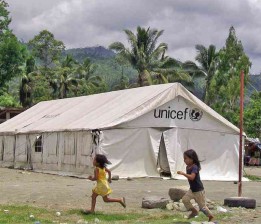30,000 Tacloban children to get vaccination

Children play outside a Unicef tent to be used as a temporary classroom for pupils in Barangay Andap, which was hit hardest by Typhoon “Pablo” when it swept through New Bataan town in Compostela Valley six months ago. FILE PHOTO
MANILA, Philippines—The World Health Organization and the United Nations Children’s Fund said on Wednesday they have joined the Philippine government’s massive vaccination drive against measles and polio for children in Tacloban City, which was hit hardest by Supertyphoon Yolanda (Haiyan).
Over 30,000 children would be reached by the campaign, which has been taking place at fixed sites in evacuation centers and in communities using mobile health teams, the UNICEF and WHO said in a joint statement.
The children also received Vitamin A supplements to help improve their immunity against infections.
“The children of Tacloban need all the protection they can get right now. Disease is a silent predator, but we know how to prevent it and we will do everything that we can,” Angela Kearney, UNICEF coordinator for the emergency response in Tacloban, said.
At the government’s request, UNICEF purchased over US$2 million worth of vaccines to replenish in-country stocks now being used for the campaign. In addition, UNICEF and WHO helped to re-establish the broken cold chain, a principle that requires the vaccines and medicines to be maintained at a low temperature to ensure their efficacy.
Article continues after this advertisementThe vaccination drive in Tacloban is the first phase of a campaign targeting children under five years old in all the typhoon-affected areas.
Article continues after this advertisementFifteen teams—10 foreign and five national—including volunteers from the Department of Health, the Philippine Red Cross and other non-governmental organizations, have gone to locations across Tacloban giving vaccines.
The first to receive them were children in 20 evacuation centers—including San Jose Elementary School, where more than 300 families currently live in conditions that can heighten the risk of infectious diseases.
Dr. Julie Hall, WHO representative in the Philippines, said WHO and UNICEF staff hand-carried supplies from Manila to Tacloban, coordinated teams to give the vaccines and trained them on how to do it under these difficult circumstances.
“It is virtually unprecedented that within two and a half weeks of a disaster of this scale, with this level of devastation and these logistical challenges, that a mass vaccination campaign is already rolling out,” she said.
During the campaign children being immunized are also screened for malnutrition by measuring their mid-upper arm circumference which will indicate if they are undernourished and require referral for treatment.